A new Los Alamos tech could give us clean energy and drinkable water
A new Los Alamos tech could give us clean energy and drinkable water Santa Fe New Mexican


Sustainable Development Goals (SDGs) and Produced Water Treatment

Introduction
By Prashant Sharan
Every day, more than 50 billion barrels of water are generated during oil and gas extraction from more than 900,000 wells. The makeup of this byproduct water — also referred to as “produced” water — is highly variable: Each stream of water contains a unique salinity and mix of impurities, including organics, heavy metals, particulates and radionuclides. But what if we could turn that produced water into clean, drinkable water? And what if we could do it with a system that actually removes most of the carbon uses, offering a carbon-neutral solution?
During oil or natural-gas extraction, water is combined with other chemicals and injected into the ground to break up the rock and release oil or gas. The liquid mixture of water, chemicals and oil or gas is brought up in a production well, after which the oil is separated out. That leaves the produced water, which is often brackish or high in salinity.
Sustainable Development Goals (SDGs)
- Goal 6: Clean Water and Sanitation
- Goal 7: Affordable and Clean Energy
- Goal 9: Industry, Innovation, and Infrastructure
- Goal 13: Climate Action
- Goal 14: Life Below Water
- Goal 15: Life on Land
Produced Water Treatment
- Turning produced water into clean, drinkable water can contribute to achieving Goal 6: Clean Water and Sanitation.
- A system that removes most of the carbon uses offers a carbon-neutral solution, aligning with Goal 13: Climate Action.
- The treatment of produced water can also support Goal 9: Industry, Innovation, and Infrastructure by promoting technological advancements in the oil and gas sector.
- By treating produced water, we can reduce the negative impact on marine ecosystems, supporting Goal 14: Life Below Water.
- Furthermore, the treatment process can help protect terrestrial ecosystems and biodiversity, contributing to Goal 15: Life on Land.
SDGs, Targets, and Indicators
1. Which SDGs are addressed or connected to the issues highlighted in the article?
- SDG 6: Clean Water and Sanitation
- SDG 13: Climate Action
- SDG 14: Life Below Water
- SDG 15: Life on Land
2. What specific targets under those SDGs can be identified based on the article’s content?
- SDG 6.3: By 2030, improve water quality by reducing pollution, eliminating dumping and minimizing release of hazardous chemicals and materials.
- SDG 13.2: Integrate climate change measures into national policies, strategies, and planning.
- SDG 14.1: By 2025, prevent and significantly reduce marine pollution of all kinds.
- SDG 15.1: By 2020, ensure the conservation, restoration, and sustainable use of terrestrial and inland freshwater ecosystems and their services.
3. Are there any indicators mentioned or implied in the article that can be used to measure progress towards the identified targets?
Yes, there are indicators mentioned in the article that can be used to measure progress towards the identified targets. The article discusses the possibility of turning produced water into clean, drinkable water with a system that removes most of the carbon uses, offering a carbon-neutral solution. This indicates progress towards improving water quality (SDG 6.3) and integrating climate change measures (SDG 13.2). Additionally, by converting produced water into clean water, it helps prevent marine pollution (SDG 14.1) and promotes the sustainable use of terrestrial and inland freshwater ecosystems (SDG 15.1).
4. SDGs, Targets, and Indicators
| SDGs | Targets | Indicators |
|---|---|---|
| SDG 6: Clean Water and Sanitation | 6.3: By 2030, improve water quality by reducing pollution, eliminating dumping and minimizing release of hazardous chemicals and materials. | – Conversion of produced water into clean, drinkable water – Removal of carbon uses in the process |
| SDG 13: Climate Action | 13.2: Integrate climate change measures into national policies, strategies, and planning. | – Carbon-neutral solution for converting produced water |
| SDG 14: Life Below Water | 14.1: By 2025, prevent and significantly reduce marine pollution of all kinds. | – Conversion of produced water into clean water to prevent marine pollution |
| SDG 15: Life on Land | 15.1: By 2020, ensure the conservation, restoration, and sustainable use of terrestrial and inland freshwater ecosystems and their services. | – Conversion of produced water into clean water to promote sustainable use of freshwater ecosystems |
Copyright: Dive into this article, curated with care by SDG Investors Inc. Our advanced AI technology searches through vast amounts of data to spotlight how we are all moving forward with the Sustainable Development Goals. While we own the rights to this content, we invite you to share it to help spread knowledge and spark action on the SDGs.
Fuente: santafenewmexican.com

Join us, as fellow seekers of change, on a transformative journey at https://sdgtalks.ai/welcome, where you can become a member and actively contribute to shaping a brighter future.







